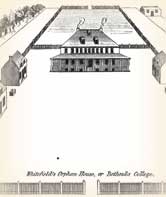 Jesus told his followers that true disciples would be known by their
fruits. The life of a genuine Christian's life will produce an
abundance of good works. Such works were clearly evident following the
spiritual revivals of the eighteenth century. All of society was
improved by the activity and work of those who had been transformed by
God's grace. Children fared better afterwards, too, for the
evangelicals showed an increased concern for child welfare.
Jesus told his followers that true disciples would be known by their
fruits. The life of a genuine Christian's life will produce an
abundance of good works. Such works were clearly evident following the
spiritual revivals of the eighteenth century. All of society was
improved by the activity and work of those who had been transformed by
God's grace. Children fared better afterwards, too, for the
evangelicals showed an increased concern for child welfare.When evangelist George Whitefield was only 25, he led the way with the establishment of an orphanage in the newly-founded colony of Georgia. Whitefield called the orphanage Bethesda, which means "House of Mercy," for he hoped many acts of mercy would be shown there. Set on 500 acres of land, the orphanage was built about 10 miles north of Savannah. On this day, March 25, 1740, construction began on the orphanage buildings. The main house was to be two stories high with twenty rooms. Two smaller buildings behind the orphanage were designed to be an infirmary and a workhouse.
Whitefield wanted the orphanage to be a place of strong Gospel influence, with a wholesome atmosphere and strong discipline. The youngsters were to be taught trades so that on becoming adults they could earn their own living. Younger children learned spinning and carding and all of the boys were taught mechanics and agriculture. Whitefield hoped that the orphanage would eventually become the foundation of a university.
Although the children grew most of their own food, the orphanage proved to be more expensive than anticipated. It became a burden to Whitefield, wearing him down with debt. Benjamin Franklin said that because of the scarcity of workmen and materials in Georgia, it would have been better to have built the orphanage in Philadelphia and moved the children there! However, Whitefield remained faithful to his contributors, who had given money specifically for the Georgia project.
At his death, Whitefield bequeathed the orphanage to Lady Huntingdon, a charitable sponsor in England. He asked that she continue the orphanage's principles and establish a college. However, from 3,000 miles away without modern communications, she was not able to provide the oversight the work needed and it almost folded.
In 1773, fire destroyed the home. Three years later, the American Revolution stymied plans to add a college. After several administrative changes, a new building and society, the Bethesda Home for Boys, was established on the same site. It continues to this day.
Bibliography:
- Adapted from an earlier Christian History Institute story by Diane Severance, Ph.D.
- Dallimore, Arnold A. George Whitefield; the life and times of the great evangelist of the eighteenth-century revival. Banner of Truth Trust, 1970.
- Demaray, Donald E. Pulpit Giants; what made them great. Chicago: Moody Press, 1973.
- Macartney, Clarence Edward Noble. Six Kings of the American pulpit. Philadelphia, The Westminster press, 1942.
- McGraw, James. Great Evangelical Preachers of Yesterday. Nashville: Abingdon Press, 1961.
- Whitefield, George. George Whitefield's Journals. Banner of Truth Trust, 1960.